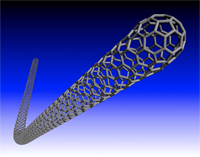Carbon nanotubes (CNT)

Nanotube simple wall.

Abestos fiber.
Carbon nanotubes (CNT) consist of one or more concentric cylinders whose dimensions vary depending on the manufacturing process (welding, chemical deposit in vapor phase, laser ablation). Generally speaking, their length can reach several microns for a typical diameter of 0.7 to 3.0 nm (monolayer tubes or SWCNT) or 10 to 200 nm (multilayer tubes or MWCNT).
By nature hydrophobic, CNTs tend to form tangled bundles and may contain metallic residues (Fe, Co, Ni, …) or catalysts (aluminates, silicates, etc.) that change their toxicity.
In some applications, CNTs may be "functionalized" on their surface to make them hydrophilic by modifying their surface (carboxylic groups, etc.). They are then able to move quickly in the organism and be eliminated in the urine.
The MWCNTs have points in common with asbestos fibers whose diameter varies from 60 nm to a few microns (amphiboles) or 20 to 30 nm (fibrils of chrysotile with the structure of hollow cylinders, and can form bundles).
A fiber is defined as a parallel-sided particle of more than 5 µm in length, diameter < 3 µm, and whose elongation ratio (diameter/length) is > 3 (WHO 1985).


